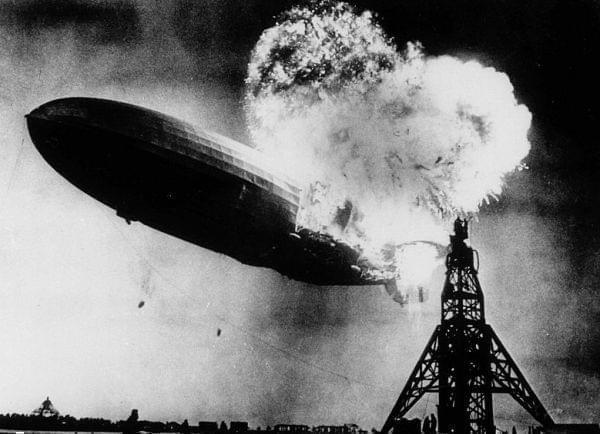80th Anniversary For Airship Disaster Immortalized By Chicago Reporter’s Recording

his photo, taken during the initial explosion of the Hindenburg, shows the 804-foot German zeppelin just before subsequent explosions sent the ship crashing to the ground at Lakehurst Naval Air Station in Lakehurst, N.J., 6 May 1937. US Navy / Wikimedia Commons
Saturday May 6 marked the 80th anniversary of an airship crash immortalized by the recorded description of a Chicago radio reporter.
People gathered at the crash site in New Jersey Saturday evening, to lay a wreath in memory of the 13 passengers, 22 aircrewmen and one person on the ground who were killed or later died from injuries suffered in the fiery crash of the German airship Hindenburg.
The Zeppelin Company's LZ-129 Hindenburg caught fire and was destroyed as it attempted to dock with a mooring mast at the Lakehurst Naval Air Station in Manchester Township, New Jersey.
USA Today reports the annual wreath-laying ceremony is usually an invitation-only event. But because of increased interest for the 80th anniversary, the site where the crash took place was open to the public for one hour prior to the ceremony.
On Friday, the Navy Lakehurst Historical Society played newsreels of the disaster, along with the recorded report of WLS Radio reporter Herbert Morrison, in which he uttered the now-immortal exclamation, “Oh, the humanity!”
Morrison's words were recorded on then cutting-edge portable equipment for later broadcast and were not broadcast until the next day. Nor were they initially linked to the film shot by newsreel crews.
A curator at New York City's Paley Center for Media says it was one of the first moments in media history that had a broadcaster reacting to something totally unexpected.
On the recording, Morrison can be heard describing the steps taken to secure the Hindenburg, when he is suddenly startled by the explosion of the airship’s supply of flammable hydrogen:
MORRISON: “The back motors of the ship are just holding it (uh) just enough to keep it from....It's burst into flames! Get this, Charlie; get this, Charlie! It's fire... and it's crashing! It's crashing terrible! Oh, my! Get out of the way, please! It's burning and bursting into flames and the... and it's falling on the mooring mast. And all the folks agree that this is terrible; this is the worst of the worst catastrophes in the world. Oh it's... [unintelligible] its flames... Crashing, oh! Four- or five-hundred feet into the sky and it... it's a terrific crash, ladies and gentlemen. It's smoke, and it's in flames now; and the frame is crashing to the ground, not quite to the mooring mast. Oh, the humanity! And all the passengers screaming around here.”
Several hypothesis have been proposed for the cause of the Hindenburg disaster, from a buildup of static electricity that ignited the airship’s hydrogen supply, to sabotage.
The widely reported incident is credited with damaging public confidence in airships, and led to the end of commercial airship travel.

